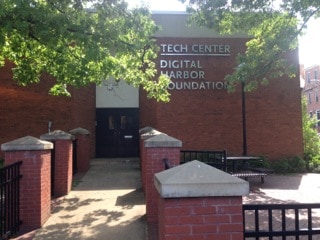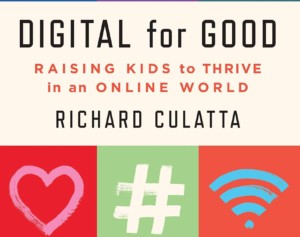Smart Cities: Baltimore’s Digital Harbor

Last Thursday night a closed recreation center became a Tech Center in Baltimore’s Federal Hill neighborhood. When Mayor Stephanie Rawlings-Blake announced the city was closing 25 of the 55 rec centers , Andrew Coy (@AndrewCoy) a teacher at Digital Harbor High School and Shelly Blake-Plock (@BlakePlock) faculty associate at Johns Hopkins University School of Education sought an alternative to the center closing. One of the rec centers was a block from Digital Harbor High School where Andrew was developing an after-school program in web design.
The closed rec center was also next to the planned location for the brand new Betamore, a tech plus entrepreneurship coworking space formed by Sean Lane. Andrew met Sean while winning the first Education Hack Day and described a new vision for repurposing from rec to tech. Sean had just created the Digital Harbor Foundation (DHF, @DHFBaltimore). Andrew signed up. Shelly joined him. That was a year ago. Rec2Tech serves three audiences: teachers can visit during the day, there’s room for 40-50 kids after school, and the center is open to community in the evening.
As MindShift noted in March, “Through Digital Harbor Foundation’s EdTech Link program, teachers will be trained by volunteer technologists, then teach their new skills to students in afterschool programs.” Coy said DHF “wants to be a STEM engine” for Baltimore as “the missing piece for STEM grads was network of support and connection to jobs.” Coy sees Web 3.0, blended learning, augmented reality, and rapid prototyping all contributing to a larger local tech ecosystem and the team at DHF has written a Common Core aligned STEM curriculum they call STEM Core to do just that.
“We need inspired EdTech,” said Shelly in an EdSurge blog, “I really don’t think we’ve begun to even imagine what the future of learning looks like.”
DHF made Audrey Watter’s list of Top Ten EdTech Startups for 2012 and said about Andrew and Shelly, “”The two have launched a number of incredibly important and innovative programs to help connect teachers, students, and technologists. A little bit teacher professional development. A little bit tech training. A lot of student empowerment.” Investor Frank Bonsall III said, “What Andrew and Shelly have accomplished at DHF is worth national press and just the beginning.”
Sterling. “ We moved Sylvan to the area from Montgomery, Alabama with 10 employees in 1991,” said Chris Hoehn-Saric of Sterling Partners. Sylvan moved to the inner harbor 15 years ago and supports more than 900 learning centers in North America today. The new SylvanSync digital instruction platform is a personalized, teacher-led instruction system “We have built the largest digital distribution network for teacher-driven instruction,” said Sylvan CEO Jeff Cohen. “And we can deliver anywhere there is an iPad.”
Along with Sylvan, Sterling has grown an impressive portfolio of education companies. Founded in 1998 as part of Sylvan, Laureate International Universities is the world’s largest private network of post-secondary institutions with 67 schools in 27 countries. Ashworth is a leading provider of secondary, post-secondary, and career-oriented accredited online education programs.InfiLaw is a consortium of law schools.Tribeca Flashpoint Media Arts Academy is a digital media arts college. Progressus partners with school districts to identify their needs in occupational therapy, speech language pathology, and physical therapy. School of Rock offers instrument and vocal programs to 7-18 years old. Meritas is a global network of college prep schools.
Sterling started test development shop Prometric, which was sold to Thomson for $780 million in 2000 and subsequently acquired by Educational Testing Service. It’s still headquartered on the Baltimore harbor.Catapult Learning provides services to school districts and was sold about five years ago. Progressus is a leading provider of speech therapy services. Wall Street Institute, spun off from Sylvan in 1997, is a worldwide English language provider. It was acquired by Pearson in 2010 but remains headquartered in Baltimore. Educate Online, formed as eSylvan in 2000, is a leading, synchronous online K-20 tutoring company. It was spun out of Sylvan in 2007.
Connections Education , launched as part of Sylvan in 2001, is a national leader in online learning operating 24 statewide virtual schools and supporting a growing network of blended Nexus Academy schools. Connections was sold to Pearson last year for more than $400 million and remains headquartered on Baltimore’s inner harbor.
“Within a mile of Sterling’s office are 8 Sterling/Sylvan incubated education companies that are leaders in their particular sector,” said Cohen,” spanning K-12 to higher ed, testing to tutoring, and supplemental instruction to full-school models.” There are only two other cities with a similar collection of proven education businesses, none with a source like Sterling.
EdTech. “Baltimore is trending well for startups, particularly edtech, healthcare and cyber software,” said Frank Bonsal III. “There is also a very robust gaming and e-commerce community in Baltimore County.” Frank’s New Markets Venture Partners is headquartered southwest of Baltimore in Howard County. He was a successful edtech investor before it was cool. Active portfolio companies include:
- The American Academy helps school prevent/recover dropouts;
- American Honors College is a selective two-year honors college;
- BetterLesson is an online lesson sharing platform;
- ConnectEDU provides data supports for college preparation and entrance;
- Overture Technologies supports responsive lending for education finance;
- Questar Assessment is a leading educational assessment provider;
- Starfish Retention Solutions supports post-secondary success;
- StraighterLine is a low cost general ed option offering a $99 per month subscription and a $1299 freshman year; and
- Think Through Learning is a K-12 distance learning company.
New Market (and affiliated fund) exits included APEI, Apex Learning, Blackboard, Capella, Flatworld, Headsprout (now Mimeo), SmartThinking, MoodleRooms, and Spectrum.
In addition to Connections, Baltimore is home to virtual school provider Calvert Education Services, recently purchased by Camden Partners.
ABS Capital Partners support late-stage growth companies including American Public Education, Rosetta Stone, TeachScape, and Whitney International University System. Partner also supports Teach for America (TFA) and local charters.
Emerging Tech Centers is a nonprofit tech and biotech incubator. The meetup space is active withB’more on Rails, Baltimore Lean Startup, Baltimore Mobile, the Tech & Social Change Baltimore Meetup, the Baltimore EdTech Meetup and the Baltimore EdTech Group.
Portfolio of Schools. Baltimore Chancellor Andres Alonso has a massive plan to rebuild infrastructure and is making progress reforming the district bureaucracy. “It’s better than it used to be,” said an edupreneur, “Alonso wants change but doesn’t know how.”
It may not always be evident, but Alonso is attempting to reform the district from within while expanding aportfolio of options. The district, serving 84,000 students, has 204 schools including 34 charter schools.
During the last decade, the local Fund for Educational Excellence led a 12 foundation consortium supporting high school reform. That work continues under the direction of former TFA Director Roger Schulman with support for 14 Secondary Transformation Schools which are operated under contract by outside groups Friendship Public Charter Schools (2 elementary and 2 secondary) and Diploma Plus (2 high schools).
Urban Teacher Center , launched by Jennifer Green, a TFA teacher who went on to senior leadership positions in Baltimore, “ensures that districts get only teacher candidates who have demonstrated effectiveness in the classroom.”
TFA Baltimore has 340 corp members in 107 schools with 600 alumni in the area. Executive Director Courtney Cass says, “We are embarking on an ambitious four-year strategy to recruit 1,000 corps members to Maryland.”
Baltimore participates in the Carnegie Foundation for the Advancement of Teaching Building a Teaching Effectiveness Network, a process improvement partnership to increase retention and effectiveness of new teachers. The district is also capturing video of teachers as part of Project Cycle, a cycle of reflection and support to improve teaching.
Cool Schools. SEED Maryland is a residential 6-12 school, modeled after SEED School in DC, supported by the Maryland State Department of Education.KIPP Baltimore runs an elementary and middle school (yes, the organized one in the papers in 2010).
College Park Academy , opening this fall, will be a blended early college charter school sponsored by University of Maryland and developed in partnership with Connections Learning. A similar Prince George’s partnership with a STEM focus has been proposed with Bowie State and Lockheed Martin.
ACCESS Online is a Connections powered program in Prince George’s County that helps over aged, under-credited students get back on track. AdvancePath supports two Baltimore County dropout prevention academies.
High functioning suburban districts include Montgomery County, what author Harold Kwalwassercalls the best district of those he profiled.
Higher Ed. “ We have 16 institutions of higher education, covering the spectrum of community college to R1,” said Frank Bonsal.
UMBC has a well respected cyber security program. President Freeman A. Hrabowski, III has been a tireless advocate for STEM education and minority participation in his 20 year term.
Towson University’s Jan Baum, a professor in the Department of Art + Design, leads the university’s cutting-edge Object Lab, where TU students learn 3D modeling and how to digitally fabricate parts and objects with 3D printers and milling machines.
Foundations. The Abell Foundation supported Digital Harbor’s Rec2Tech and has made someventure investments. The Annie E. Casey Foundation has supported charter schools andKidsCount–a long term commitment to measuring child welfare metrics. The Howard Hughes Medical Institute (Chevy Chase) makes grants that are changing how science is taught and conducted.
State of Play. Maryland has been recognized for strong standards, but it is clueless when it comes to options with a terrible charter law and almost no online learning. CER Parent Power Indexranks Maryland close to the bottom, “Maryland has one of the weakest charter laws in the country because of the enormous obstacles charter applicants face from school boards. Charters face outward hostilities from boards and are micromanaged, operationally limited, and poorly funded.”
The Digital Learning Now! state scorecard illustrates Maryland’s limited access to online and charter school options. Despite the presence of the world’s most important online learning providers in the DC-Baltimore corridor, the “Maryland charter school law effectively prohibits online charter schools,” says Keeping Pace, and students can only take an online course with “permission from the local system and school principal.”
Baltimore Education Ecosystem. Education innovation among Baltimore creatives and technologist is on the rise. A new EdTech incubator is scheduled to open in the second quarter of this year and a recent report by the Economic Alliance of Greater Baltimore identifies EdTech as a prime mover in the city’s burgeoning tech economy.
It’s interesting that a gifted teacher like Andrew Coy left the district’s most advanced tech school to start an after school program. Most tech curriculum remains focused on the software of the last decade while Coy and his kids are creating the tools of this decade. Can an urban district remain relevant if “not connected to current needs of the tech economy”?
It’s also interesting how two teachers can help change the energy level in a city and, perhaps, spark a revolution in learning.
Stay in-the-know with all things EdTech and innovations in learning by signing up to receive the weekly Smart Update. This post includes mentions of a Getting Smart partner. For a full list of partners, affiliate organizations and all other disclosures please see our Partner page.







Tom Vander Ark
Forgot Supporting Public Schools of Choice (http://supportingpublicschools.org), they works with charter, transformation & nontraditional schools in the Baltimore City Public Schools. Carol Beck is the director.
http://twitter.com/SPSOC
Tom Vander Ark
Connections Education was named by Baltimore magazine as one of Baltimore's "Best Places to Work," as featured in the February issue
Tom Vander Ark
RiShawn Biddle makes the case that Andres Alonso’s Departure is An Opportunity for Baltimore to Move Beyond the Traditional District
http://dropoutnation.net/2013/05/07/andres-alonsos-departure-an-opportunity-for-baltimore-to-move-beyond-the-traditional-district/